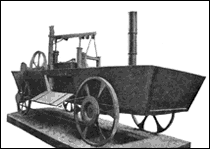Speaking of power, I didn't watch the Republican (master)debates last night, but I hear Trump slipped Jeb some skin.
Good thing they didn't fist bump, or their Wonder Tard Powers would have activated. And then what?
So, food. Again. Still. Probably for awhile. Hey, let's talk about Oliver Evans. I think in many respects, Oliver Evans kicked Leonardo DaVinci's ass when it came to inventions. True, Leonardo came with lots of unworkable and impractical inventions, a lot more than Evans, but unlike Leonardo, Evan's rubber always hit the road.
Oliver Evans, along with Richard Trevithick, came up with the high pressure steam engine. Oliver Evans built the Orukter Amphibolos, the world's first automobile and the world's first amphibious vehicle. When he drove it through Philadelphia's Center Square in 1805, thousands gathered in amazement.
But much important a contribution was Evan's automatic flour mill, developed to fruition around 1789.
"He saw the method by which millers turned wheat into flour and he was disgusted by the crudity, waste, and dirtiness. A mill customarily employed four men and a 'hopper boy' to clean, grind, cool, sift, and pack. One strong man carried three-bushel sacks up ladder-like stairways and dumped the grain into cylindrical 'rolling screen' that freed the grain of its chaff and dirt. A boy raked the cleaned grain into a funnel or hopper leading to the second-floor millstones, driven by waterpower. The warm, moist, ground meal was packed into buckets and hoisted to the third floor. It was spread out on the floor to cool and dry. A third man pushed the dried meal into a vertical chute. Gravity carried it into cylinder covered in bolting cloth. Once sieved, the flour fell into a chest and a fourth man shoveled it out into barrels. In all this labor, dust was raised, grain was trampled underfoot, and the flour quality was very mixed."*"Mixed" was an understatement, the flour typically had manure, insects, offal, trash, and any number of other very undesirable things embedded within it. Aside from the amount eaten by vermin, most of it spoiled before it could make it to market - where it was used anyway.
Evans' ingenious automatic integrated production line used one man, doing the work of, who could process 300 bushels an hour. In addition, the raw gain emerged as smooth flour untouched by human hand, devoid of hopper dust, footmarks or insects. Footmarks, in case you haven't figured it, was anything that became attached from the incredibly filthy mill dirt and mud of the mill yards.
His process was promptly denigrated as "a set of rattle-traps, and also shamelessly ripped off by millers up and down the Eastern seaboard, and it was not until Congress passed an act for the Relief of Oliver Evans, signed into law by President Jefferson in 1808, that he was able to receive partial recompense. As usual, as is such the case of so much of capitalism in America, his inventions were "stolen fair and square". From the monies recovered, he founded the Mars Works west of Pittsburgh, continuing to manufacture steam engines until his death. The steam engine was something for sure. But, more importantly, there is little doubt that Americans, eating flour milled by Evans' mills, were more likely to live to tell the tale, and certainly had an impact in being able to reproduce at "biological maximum", and spread westward ho.


No comments:
Post a Comment